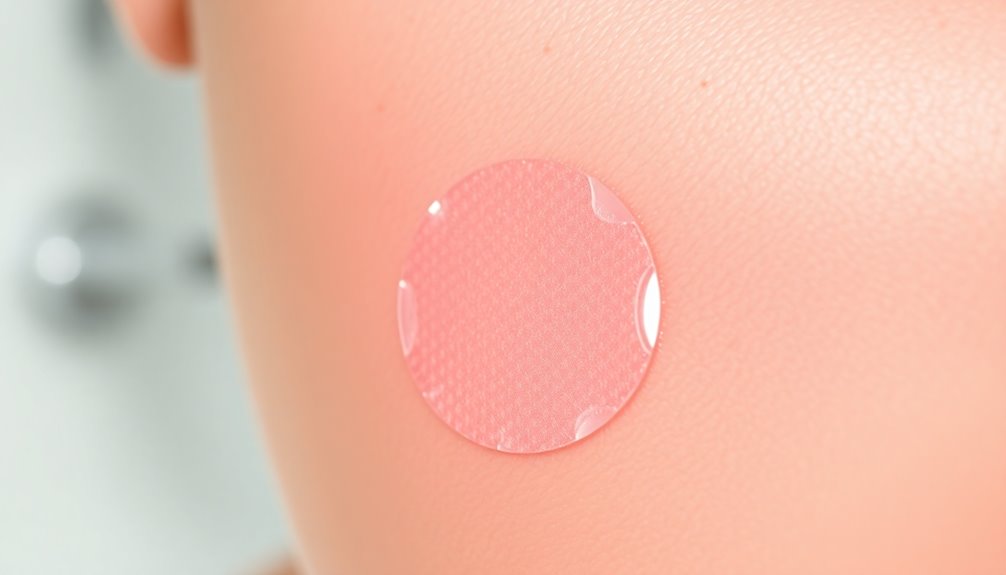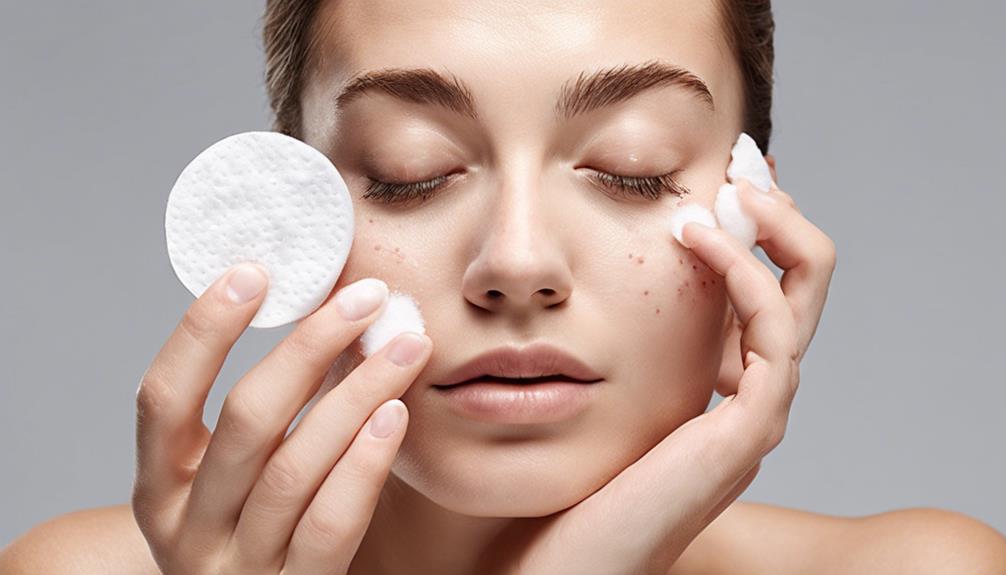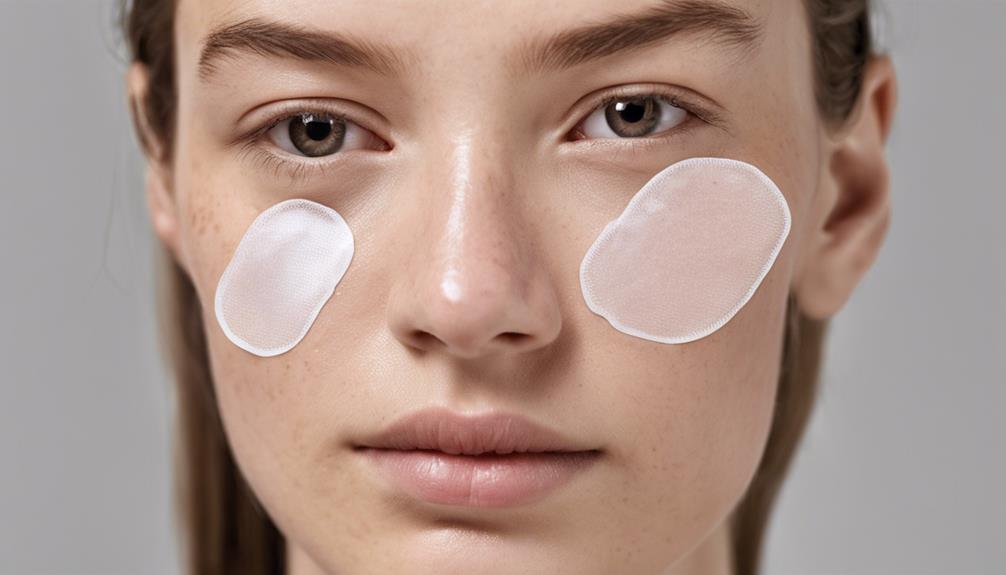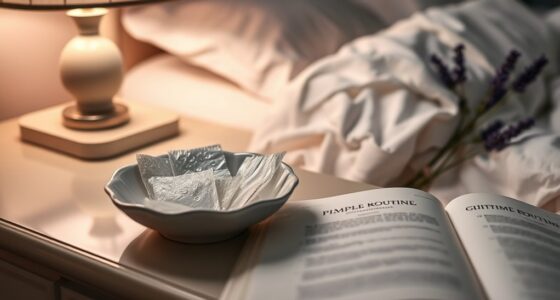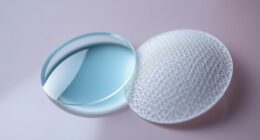Pimple patches work by sticking directly onto your acne, creating a moist environment that fosters healing. They absorb excess fluid and impurities, turning white or cloudy as they do. Made from hydrocolloid material, these patches serve as a barrier against irritants while reducing inflammation. They're particularly effective on surface-level pimples. When applied correctly, you can expect a noticeable reduction in size and inflammation. Discover more about their ingredients and how to use them effectively.
Key Takeaways
- Pimple patches utilize hydrocolloid material to absorb excess fluid and pus, promoting healing of acne lesions.
- They create a moist environment that accelerates the healing process and reduces inflammation.
- Active ingredients like salicylic acid and tea tree oil enhance their effectiveness by unclogging pores and providing antibacterial properties.
- The patches act as a protective barrier, preventing external irritants from worsening the acne.
- Leaving the patch on for several hours maximizes absorption and reduces the size of pimples, especially pustules and papules.
Understanding Pimple Patches: What Are They?

When you're dealing with a breakout, pimple patches can be a game changer. These adhesive hydrocolloid dressings are designed to stick directly onto your acne, creating a moist environment that promotes healing.
Made from a gel-forming material, pimple patches absorb excess fluid and impurities from the blemish, often turning white or cloudy as they work. They act as a barrier against external irritants, helping to reduce inflammation and prevent infection, which minimizes the risk of picking or popping.
Available in various sizes and thicknesses, these patches offer discreet, targeted treatment for individual breakouts. Often recommended by dermatologists, pimple patches are particularly effective for surface-level pimples, although their effectiveness may vary based on your specific type and severity of acne. Additionally, using patches before other skincare products can enhance the effectiveness of blemish treatment and support targeted treatment of active breakouts.
The Composition and Appearance of Pimple Patches
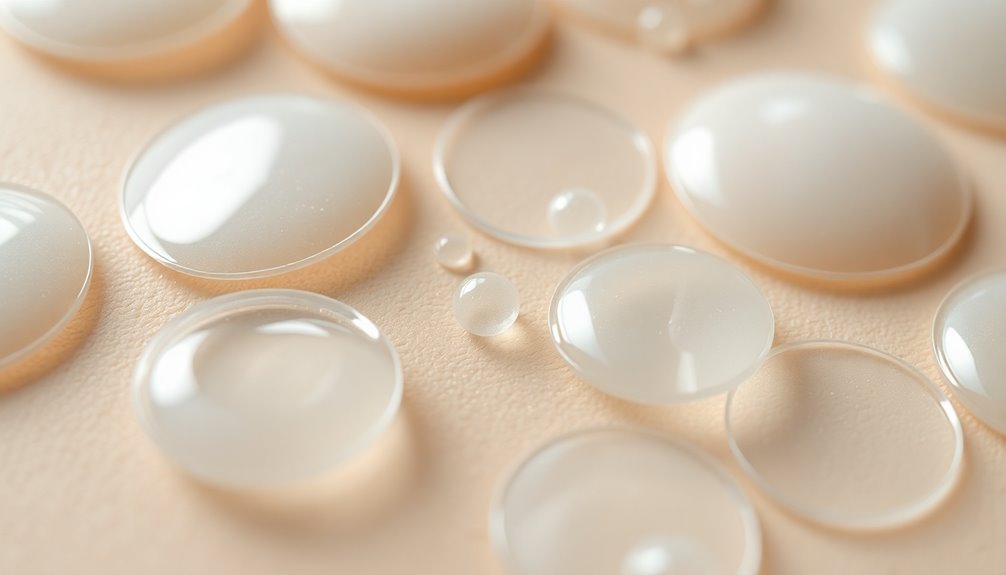
Pimple patches are crafted from materials like hydrocolloid, which helps absorb moisture and promote healing.
You'll notice they come in translucent or skin-toned designs, making them easy to wear discreetly.
With various sizes available, you can choose the perfect patch to tackle your specific pimple or acne lesion. Additionally, these patches utilize hydrocolloid technology to create a protective barrier against bacteria and dirt, enhancing their effectiveness.
Material Types Used
Crafted for effective acne treatment, pimple patches primarily consist of hydrocolloid, a gel-forming material that absorbs excess fluid and promotes a moist healing environment. These patches often include active ingredients like salicylic acid or tea tree oil, targeting skin concerns through their antibacterial and anti-inflammatory properties. Additionally, it is important to be aware that some individuals may experience allergic reactions to certain materials in these patches.
| Material Type | Purpose |
|---|---|
| Hydrocolloid | Absorbs excess fluid |
| Salicylic Acid | Treats acne and reduces inflammation |
| Tea Tree Oil | Antibacterial properties |
| Translucent Design | Discreet use during the day |
| Varying Thickness | Enhanced delivery at night |
With different sizes available, pimple patches cater to various pimple types, ensuring targeted and effective acne treatment.
Design and Aesthetics
The design of pimple patches emphasizes both functionality and aesthetics, guaranteeing they blend seamlessly into your skincare routine. Made primarily from translucent or skin-toned hydrocolloid material, these patches minimize visibility, making them discreet for daytime wear.
They come in various sizes to effectively cover different pimple types, providing tailored treatment options. Some patches are thicker for nighttime use, delivering more active ingredients, while thinner versions easily conceal under makeup.
The clever design also guarantees excellent adherence, keeping the patches in place during daily activities. Many patches change color to white or cloudy as they absorb exudate, indicating their effectiveness in drawing out fluid from pimples.
This unique appearance adds to their appeal while highlighting their functionality. Additionally, proper application timing can enhance the overall effectiveness of pimple patches in your skincare routine.
Key Active Ingredients in Acne Patches
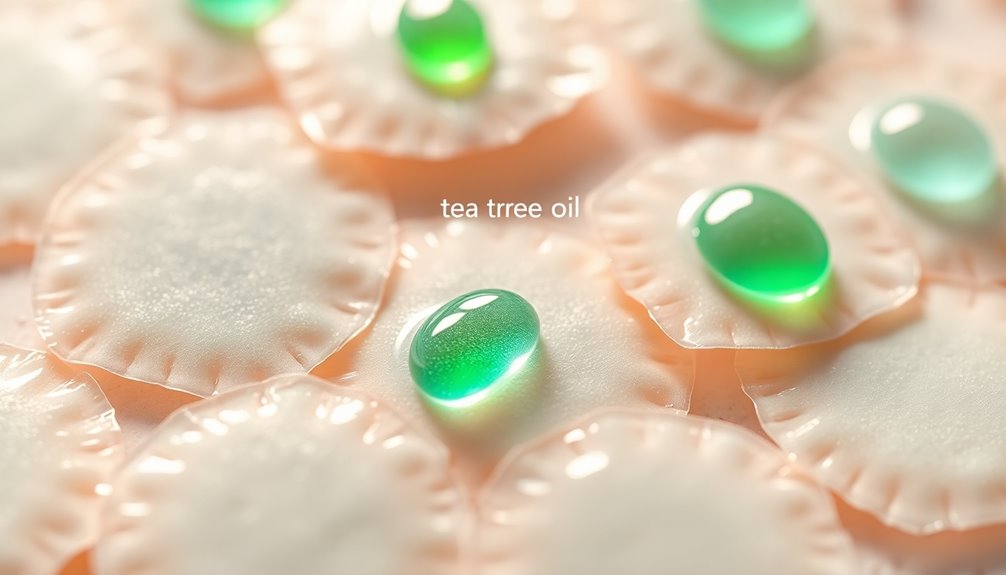
When dealing with acne, understanding the key active ingredients in acne patches can greatly enhance your treatment approach.
Hydrocolloid is the primary material in these patches, designed to absorb excess fluid and pus while maintaining a moist environment that promotes healing.
Salicylic acid is often included to help exfoliate your skin and unclog pores, making it effective for blackheads and whiteheads.
You might also find tea tree oil, known for its antibacterial properties, which helps reduce inflammation and kill acne-causing bacteria.
Additionally, niacinamide improves skin tone and texture while stabilizing your skin barrier to prevent future breakouts.
Together, these ingredients work synergistically to tackle stubborn blemishes effectively. Furthermore, maintaining a healthy digestive system can also play a role in achieving clearer skin, as a balanced gut microbiota supports skin health.
How Do Pimple Patches Work?

Understanding how pimple patches work can help you make the most of your acne treatment. These patches are made from hydrocolloid material, which absorbs excess fluid and pus while creating a moist environment that promotes healing.
When you apply a pimple patch to a pimple, it draws out drainage, becoming white or cloudy as it absorbs exudate. This occlusive nature protects the area from irritants, preventing further infection and inflammation.
Pimple patches are especially effective on open, draining pustules and cysts, helping to reduce their size and inflammation in just a few hours. Many also contain active ingredients like salicylic acid or tea tree oil, enhancing their ability to fight acne and soothe irritation. Additionally, incorporating products with glycolic acid can help improve overall skin texture and prevent future breakouts.
Different Types of Pimple Patches

When it comes to pimple patches, you'll find a variety of options to suit your needs. Hydrocolloid patches are great for absorbing excess fluid and speeding up healing, while medicated patches pack active ingredients like salicylic acid for extra support. Understanding these differences can help you choose the right patch for your skin type and acne severity. Additionally, the effectiveness of these patches often depends on the active ingredients used in their formulation, which can significantly enhance the healing process.
Hydrocolloid Patches Overview
Hydrocolloid patches have become a popular solution for treating acne, thanks to their ability to create a moist healing environment.
These patches work by absorbing moisture and excess fluid from raised pimples, effectively flattening the pimple while promoting skin healing.
You'll find different types of hydrocolloid patches available, including medicated patches that contain active ingredients like salicylic acid or tea tree oil to specifically target bacteria and inflammation.
Microneedling patches are another option, designed to deliver these active ingredients deeper into your skin for enhanced acne treatment.
With varying sizes and thicknesses, you can choose the right patch that fits your acne severity and whether you prefer day or night use.
It's important to note that certain oils, like tea tree oil, can be effective in treating acne but should be used with caution, especially around pets.
Medicated Patches Features
Medicated pimple patches offer targeted solutions for various types of acne, making them a versatile addition to your skincare routine.
These medicated patches often contain active ingredients like salicylic acid, which helps unclog pores and reduce inflammation. Some patches incorporate tea tree oil for its antibacterial properties, effectively reducing redness and swelling.
Hydrocolloid dressings are a common type that absorbs impurities from pimples, creating a moisture environment that promotes wound healing and protects against external irritants.
You can choose from different patches tailored for raised pustules, inflammatory acne, or even stubborn cystic lesions. With this variety, you can find the perfect patch to combat your specific acne-causing concerns. Additionally, understanding the effectiveness of air purifiers can help improve overall skin health by reducing airborne irritants that may exacerbate acne.
Effective Usage: A Step-by-Step Guide

To effectively use pimple patches, start by verifying your skin is clean and dry. First, cleanse the skin thoroughly and pat it dry.
Next, choose a patch that fits the size of the pimple completely, allowing the hydrocolloid material to work its magic. Press the patch onto the affected area firmly to minimize air bubbles and verify a strong bond.
Choose a patch that fully covers the pimple, ensuring a strong bond for optimal absorption and healing.
Leave the patch on for several hours or overnight to allow it to absorb fluid and promote healing. When it's time, gently remove the patch and clean the area.
Avoid using the patch on open wounds or irritated skin for the best outcomes. Following these steps will help you maximize the effectiveness of your pimple patches. Additionally, using eco-friendly cleaners can help maintain overall skin hygiene and prevent future breakouts.
Evaluating the Effectiveness of Pimple Patches
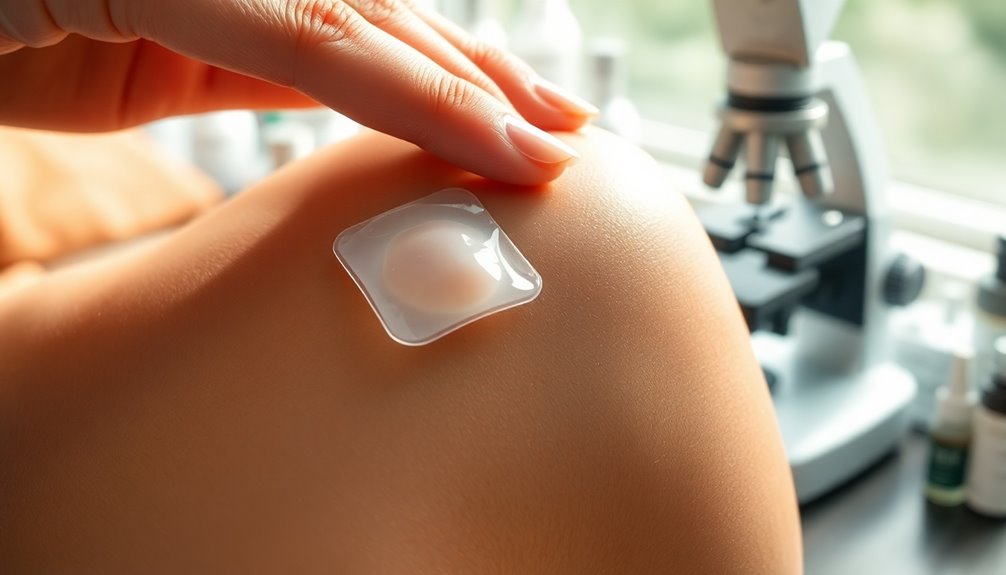
While many swear by pimple patches for quick relief, evaluating their effectiveness requires understanding how they work.
Primarily made from hydrocolloid, these patches absorb drainage from pimples, creating a moist environment that promotes healing. Studies show that when you leave them on for several hours, especially overnight, they can considerably reduce the size and inflammation of active lesions.
Medicated versions containing active ingredients like salicylic acid and tea tree oil can further enhance their effectiveness by targeting bacteria and inflammation.
However, keep in mind that pimple patches are most effective on open, draining lesions like pustules and papules, and they won't work on closed comedones or cystic acne, limiting their application for some acne types.
Exploring Alternatives to Pimple Patches
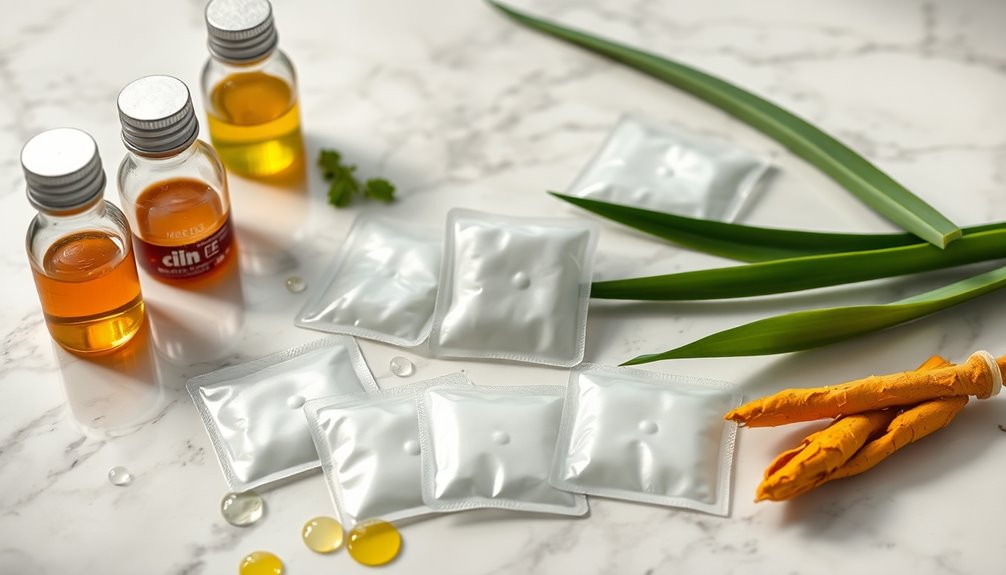
Pimple patches can be effective for certain types of acne, but they're not the only solution available. If you're looking to prevent acne or treat existing breakouts, consider over-the-counter options like salicylic acid and benzoyl peroxide.
These active ingredients in foaming cleansers help unclog pores and reduce inflammation. For a natural approach, tea tree oil offers antibacterial properties, although you should use it cautiously to avoid irritation.
Additionally, topical retinoids like adapalene work by promoting skin cell turnover and reducing pore clogging. If your acne is more severe, consult a dermatologist for personalized care, which may include stronger spot treatments or oral medications.
Frequently Asked Questions
How Do Pimple Patches Work Scientifically?
Pimple patches work by using hydrocolloid material that absorbs moisture and pus from your blemish.
When you place a patch on a pimple, it creates a gel-like barrier that keeps the area hydrated and protected from irritants. This process helps reduce inflammation and speeds up healing.
Some patches even include ingredients like salicylic acid to target bacteria. Overall, they're effective for minimizing the size and redness of pimples when used consistently.
Do Pimple Patches Work on Unpopped Pimples?
Imagine a sponge soaking up spilled juice on your kitchen counter. That's how pimple patches work on unpopped pimples.
They're most effective on pimples that are open, draining, and healing. You'll notice that they absorb excess fluid, reduce inflammation, and create a protective barrier.
Just stick one on your pimple overnight, and you'll likely wake up to a less swollen, red spot. So yes, they can definitely help!
What Causes Pimple Patches to Work?
Pimple patches work due to their hydrocolloid technology, which absorbs excess fluid and pus, creating a moist environment that speeds up healing.
When you apply a patch, it sticks to your skin, preventing you from picking at your pimple. The patches often contain ingredients like salicylic acid, which help reduce inflammation and unclog pores.
As the patch does its job, it'll change color, signaling that it's effectively absorbing the impurities.
How Do Pimple Patches Extract Pimples?
Isn't it ironic how something so simple can tackle your pesky pimples? When you stick a pimple patch on, it works like a tiny vacuum. The hydrocolloid material absorbs excess fluid and pus, drawing it out and reducing inflammation.
You'll notice the patch changes color, signaling its effectiveness. Plus, it acts as a barrier, keeping irritants away and reducing your urge to pick, which helps prevent scarring and speeds up healing.
Conclusion
To summarize, pimple patches can be a game-changer for many dealing with breakouts. Did you know that nearly 85% of people aged 12 to 24 experience acne? That's a staggering number, highlighting how common this struggle is. By understanding how these patches work and using them effectively, you can take charge of your skincare routine and feel more confident in your skin. So why not give them a try and see the difference for yourself?
